COVID-19 pandemic in Ohio
The COVID-19 pandemic was confirmed to have reached the U.S. state of Ohio in March 2020.
| COVID-19 pandemic in Ohio | |
|---|---|
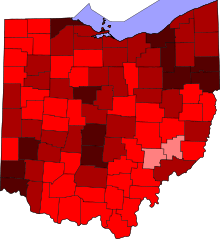 COVID-19 cases in Ohio by counties as of June 27, 2020 at 2pm >1,000 confirmed cases
100-999 confirmed cases
10–99 confirmed cases
1–9 confirmed cases | |
| Disease | COVID-19 |
| Virus strain | SARS-CoV-2 |
| Location | Ohio |
| Index case | Cuyahoga County |
| Arrival date | January 2, 2020 |
| Confirmed cases | 45,969 |
| Suspected cases‡ | 3,486 |
| Hospitalized cases | 7,624 |
| Critical cases | 1,916 |
Deaths | 2,804 |
| Government website | |
| coronavirus | |
| ‡Suspected cases have not been confirmed as being due to this strain by laboratory tests, although some other strains may have been ruled out. | |
Ohio's first cases were reported on March 9, and the first death was reported on March 19. Later, when more tests became available, records show cases had actually started early January and the first confirmed death was March 17. Limited test availability continued to hinder the acquisition of accurate numbers. By April 23 Ohio had 656 confirmed deaths and by May 1 there were 1002 confirmed deaths.
Acting on advice from Ohio's Department of Health director Amy Acton, Governor Mike DeWine declared a state of emergency on March 9 when the state had only three confirmed cases and no deaths yet. Dr. Acton issued a stay-at-home order effective March 23.
On March 27, Acton projected Ohio cases to peak in mid-May at 10,000 per day. By the first week in April, crediting Ohioan's compliance with social distancing requests, she had revised the projection to mid-to-late April or early May. On April 8, Acton said that the effectiveness of physical distancing being incorporated into modeling led to a revised projection of a new peak of 1,600 new cases per day in late April. On April 14 she revised the projection to a peak on April 19.
On April 16 Governor DeWine announced that Ohio would start re-openings on May 1. On April 20, after comprehensive testing had been done at prisons, Acton said the prison testing results were indicating that as many as 70% of cases may be asymptomatic.
Age ranges
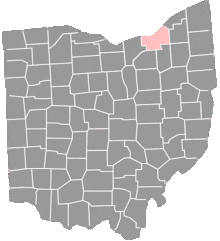

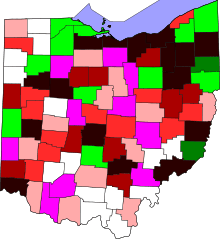
| Age | Cases | Hospitalizations | Deaths | % fatal |
|---|---|---|---|---|
| 80+ | 4,648 | 1,437 | 1,479 | 31.8 |
| 70–79 | 4,035 | 1,456 | 684 | 17.0 |
| 60–69 | 6,081 | 1,671 | 405 | 6.7 |
| 50–59 | 7,717 | 1,353 | 164 | 2.1 |
| 40–49 | 7,555 | 750 | 41 | 0.54 |
| 30–39 | 8,294 | 505 | 19 | 0.23 |
| 20–29 | 8,052 | 326 | 11 | 0.14 |
| 0–19 | 3,031 | 125 | 1 | 0.03 |
| Total | 49,455 | 7,624 | 2,804 | 5.7 |
Source: Ohio dashboard, June 27, 2020.[20]
Note: all data is preliminary and subject to change as more information is reported
Spread of virus
On March 9, Governor Mike DeWine reported Ohio's first 3 cases in Cuyahoga County, a couple who had returned from a Nile River cruise, and a man who had returned from an annual conference in Washington, DC where other cases of coronavirus had been reported.[21] Two days later, a fourth case, and the first instance of community spread, was confirmed by DeWine in Stark County.[22] Later tests showed the first case was February 15.
By March 13, there were a total of 13 cases, with 159 others under observation.[23][24] Within a week the first death was announced. Mark Wagoner, Sr, a prominent Toledo attorney and friend of DeWine, died March 19.[25] Later tests showed the first coronavirus death had been March 17.
By March 23 there were a cumulative 442 COVID-19 cases, 6 of which resulted in death.[26] By April 5 there were 4,043 cases, 1,104 hospitalizations including 346 ICU admissions, and 119 deaths.[20] As of April 9, twenty percent of cases involved healthcare workers.[20] By April 13 there were 6,975 cases, 2,033 hospitalizations including 613 ICU admissions, and 274 deaths.[20] On April 14, Ohio had an additional 50 deaths for a total of 324.[27]
By April 14, Ohio was expecting the peak to happen on April 19.[28]
By April 17 the state had 9,107 confirmed and probable cases including 418 confirmed and probable deaths.[29] On the 25th the number of cases reached 15,587 and the number of deaths reached 711.[30] By April 28 Ohio had 16,769 cases, 3,340 hospitalizations including 1,004 ICU admissions, and 799 deaths. On April 28, Vinton County first had cases reported to the state, so all 88 counties in Ohio had confirmed cases.[20] By May 4, there were 20,474 cases reported, including 1,056 deaths.[31]
On May 12 Ohio had reached 25,250 total cases, including 1,232 ICU admissions and 1,436 deaths. On May 12, the state department of health noted that antibody tests showed presence of the disease as early as January 7, with positive results in several counties in January.[32]
On May 20, the state announced that 1,247 of 1,781 deaths announced to that date, or 70 percent, were in nursing home or long-term care facilities.[33] By May 26 there had been 33,006 reported cases, leading to 5,579 hospitalizations and 2,002 deaths. 1,450 of the hospitalizations were ICU admissions.[34]
Government response
Acting on advice from Ohio Department of Health Director Amy Acton;[35] Governor DeWine was one of the first state governors to "sound the alarm" about the coronavirus threat, taking action before Ohio had any confirmed cases.[36] Axios called him "among the leading governors in the country sounding the alarm about the threat of the coronavirus."[36] The Washington Post called his and Acton's response "a national guide to the crisis" and "textbook recommendations,"[37] pointing out numerous occasions when moves taken by Ohio were soon followed by other states.[38] The Hill said he'd "been one of the most aggressive governors in responding to the pandemic".[39]
Prior to the state having any confirmed cases, on March 3, DeWine made the decision to cancel the Arnold Classic, a move which the Washington Post noted as seeming "radical" at the time.[38][40] The estimated economic impact for the state was $53 million.[40]
On March 5, when the state still had no confirmed cases, DeWine and Acton held a summit on COVID-19 preparedness for public health officials in the state.[41][42]
DeWine declared a state of emergency on March 9, when the state had only three known cases.[43] That same day he asked colleges and universities to go to online classes.[44] Within days many colleges and universities had taken steps to comply.
On March 12, DeWine announced that all schools from K-12 would close for a 3-week break, starting March 16;[45] he was the first governor to announce statewide school closings.[36] The Ohio Department of Education updated their guidelines for ensuring schoolchildren received meals, announcing that each district would make independent decisions about providing reduced and free breakfast and lunch to students during the break but encouraging districts to ensure needs were met and stating the department would continue to reimburse districts for meals served during the closure.[46]
Also on March 12, Ohio Department of Health director Amy Acton instituted a ban on gatherings of more than 100, with exemptions for airports, workplaces, restaurants, religious gatherings, weddings and funerals.[47] Despite having only thirteen confirmed cases at the time, Ohio officials were predicting that there were over 100,000 cases in the state.[48] Department of Health director Acton compared the small number of cases to "seeing a star and knowing that light is a moment from the deep past"[49] as she argued for Ohioans to take steps to prevent further infections that could overload the state's hospitals.[49] State Representative Emilia Sykes called Acton "the real MVP of Ohio's coronavirus response."[49]
DeWine and Acton on March 14 recommended Ohioans postpone elective surgeries.[50]
DeWine and Acton ordered the closure of all bars and restaurants starting 9:00 PM EDT March 15, 2020, saying the government "encouraged restaurants to offer carryout or delivery service" but that they "would not be allowed to have people congregating in the businesses."[51][47] DeWine said he was "concerned that with St. Patrick's Day coming up Tuesday, people would ignore warnings and go out to bars."[52] Closing of the state's estimated 22,000 restaurants was expected to affect some 500,000 workers.[53] DeWine instituted a liquor buyback program[39] and expanded Ohio's unemployment insurance to cover laid-off restaurant workers. The state waived the qualifying waiting period as well as the requirement that individuals receiving jobless benefits must seek new employment. The action also was extended to workers who are under quarantine or those who work in health care.[54] DeWine announced his intention to close daycares and recommended parents remove their children from daycare if possible.[36]
DeWine said of the closings:[36]
Establishments can stay open for carry-out and delivery. What we can't have is people congregating and seated. Every day we delay, more people will die. If we do not act and get some distance between people, our health care system in Ohio will not hold up. The loss won't only be those impacted by COVID19, but the danger is also to everyone else who needs hospital care for other issues."
— Mike DeWine
Acton stressed the importance of "flattening the curve", saying:[55]
When our hospital systems are overwhelmed, that means if you are having a birth that you are planning, if you are in a car accident and need your hospital, if you have a stroke or an MI, even if you never get coronavirus, people in this country can die from something other than coronavirus.
— Amy Acton
On March 16, DeWine banned gatherings of more than 50 people and on March 17 he ordered that all elective surgeries be postponed;[56] controversially, the state government indicated that this included abortions.[57] On March 18, DeWine announced that 181 BMV locations will close until further notice. Five will stay open to process commercial driver license applications and renewal. DeWine asked the state legislature to pass a grace period for people whose licenses expired. Barbershops, salons, and tattoo parlors closed.[58] Businesses that do stay open will have to take every employee's temperature every day before they start work and send anyone with a temperature over 100.4F home; DeWine warned that if businesses did not comply he would close all nonessential businesses.[59][60] Mayor Andrew Ginther declared a state of emergency in Columbus, Ohio.[61]
On March 19 Governor DeWine signed state active duty proclamation that will activate 300 personnel from the Ohio National Guard, as well as a contingent of Ohio Military Reserve personnel, to help with humanitarian efforts.[62] On March 20 DeWine ordered senior citizens centers to close by March 23.[63][64] The next day he closed adult day services serving more than ten people at a time, saying he had delayed closing them until ensuring provision had been made to care for those served in them.[65]
On March 22, Acton issued a statewide stay-at-home order to take effect from midnight on March 23 to through April 6, requiring the closure of nonessential businesses.[2] DeWine ordered most childcare facilities to close beginning March 26. The State of Ohio Board of Pharmacy approved restrictions on the dispensing of chloroquine and hydroxychloroquine to treat COVID-19.[2]
DeWine said that because of the economic fallout from the closures, the state would need to slow down the rate of spending...rather dramatically," announcing on March 23 a hiring freeze for the state, a freeze on new contract services, and a continuation of the freeze on state employee travel. He asked cabinet members to find budget cuts of 20%.[66] According to Lieutenant Governor Jon Husted, Ohio would at the request of the Trump administration desist from publicizing unemployment figures.[67]
On March 24 Jim Bridenstine announced that a number of NASA facilities would be moved to stage 4 where non-critical infrastructure is closed, including the Glenn Research Center in Cleveland, and the Plum Brook Station near Sandusky.[68]
Acton on March 24 estimated that Ohio was 7 to 14 days behind New York state, which at the time was overwhelmed.[69] On March 26 Acton announced that 17, 316 Ohioans had been tested.[70] On March 27 Acton said the state was at that time expecting cases to peak in mid-May at 10,000 new cases per day.[71]
On March 25, the Ohio General Assembly passed House Bill 197, which does many things, such as extending primary voting to April 28, banning water utilities from disconnecting service, and waiving standardized testing for public schools.[72][73]
On March 28, DeWine asked the FDA to issue an emergency waiver for the use of new technology that can sterilize face masks.[74]
On April 2, Governor DeWine announced during his daily press conference that there is a new method to divide the state into hospital capacity regions.[75]
On April 3, DeWine extended Ohio's stay at home order through May 1 with new restrictions: campgrounds must close, all retail businesses must post signs limiting how many are allowed in at one time, and wedding receptions are limited to 10 people. The order also establishes a state board to evaluate what is and is not an essential business.[76]
On April 4 Ohio recommended the wearing of cloth face masks when leaving home as a way to protect others.[77] DeWine signed an executive order removing training requirements for mental health and marriage counselors to make telehealth visits more easily accessible.[78]
On April 6 DeWine named six facilities that will be converted into health care facilities if necessary: the Dayton Convention Center, the Duke Energy Center in Cincinnati, the Greater Columbus Convention Center, Seagate Convention Center in Toledo, Case Western Reserve University's Health Education Campus in Cleveland, and the Covelli Convention Center in Youngstown. Also on April 6, Ohio House Speaker Larry Householder named 24 lawmakers to a task force dedicated to studying how the House can speed up economic recovery.[79]
On April 9 the Ohio Department of Health released a video demonstrating the effect of social distancing that went viral.[37][80] According to the Washington Post:[80]
A video from the Ohio Department of Health shows a minefield of mousetraps and table tennis balls, row upon row, that turn into a predictable maelstrom of flying debris once a bouncing ball tumbles into view. It’s also a metaphor for the menacing spread of the coronavirus, where just one person interacting with others can produce a chain reaction of devastating consequences. The video is among the clearest visualizations yet of how proximity can turn lethal — and, conversely, how isolation can turn the tide. In the second half of the video, the traps are spaced at greater distances as a table tennis ball bounces across the floor without triggering any hazards.
On April 15, DeWine announced that he had asked the Ohio Hospital Association to begin developing a plan to start treating people whose non-COVID-19 elective procedures were deferred or delayed. DeWine also announced that Ohio's partnership with the Battelle Memorial Institute was expanding. This will allow the institute to extend their sterilization services to EMS providers and law enforcement agencies.[81] On April 16 DeWine announced that he would work closely with the Governors of Illinois, Indiana, Kentucky, Michigan, Minnesota, and Wisconsin to reopen the region’s economy in a coordinated way.[82]
The Ohio Department of Health establishes a tier system to prioritize testing on April 22.[83] Ohio: DeWine shares additional details on how the state will re-open. Phase one of the re-opening will begin on May 1.[84]
On April 20, Governor DeWine announced that Ohio’s K-12 schools would remain closed for the remainder of the academic year.[85]
On April 30 DeWine and Acton amended the stay-at-home order and extended it to May 29, calling it the "Stay Safe Order."[86] Some businesses were allowed to open on a limited basis, including dentists and veterinarians on May 1, manufacturing, distribution, construction, and general offices on May 4, with employees working from home if possible, and retail businesses on May 12 with employees and customers wearing masks.[86]
On May 19 Governor DeWine announced an "Urgent Health Advisory: Ohioans protecting Ohioans" order. Elements of the previous stay-at-home order became "strong recommendations."[87] The following day DeWine announced that three new orders had been signed. One order partially rescinds the April 30 Stay Safe Ohio Order, one issues a series of health advisories, and the Camp Safe Ohio Order specifies how campgrounds in Ohio can reopen.[88]
On June 18, Dewine expressed concern about a spike in cases in southwestern Ohio and suggested that people in 13 specific zipcodes (within 5 counties: Hamilton, Montgomery, Greene, Warren, and Clark) should get tested. He said National Guard units would be in the area to provide help with the testing.[89]
Reopenings

If onset date is unknown, the earliest known date associated with the case is used as a substitute for the date of illness onset.
Seven day average is calculated by adding number of cases on seven days centered on date divided by seven
Source: Ohio coronavirus dashboard[20]
Note: data for most recent several days is preliminary and likely to increase as new data is reported to the state
Federal guidelines called for 14 days of decreasing cases to begin reopening economy
On April 14 DeWine said he couldn't imagine any businesses reopening without employees wearing masks.[28] DeWine announced April 16 that some reopenings would start on May 1.[90] On April 16, Trump announced that states could restart their economies when they had 14 days of declining cases.[91]
On April 27, the governor announced Phase 1 of the state's reopening plan. The businesses allowed to reopen would be on this schedule:[92]
- Friday, May 1: Hospital, medical, dental and veterinary services that don't require an overnight hospital stay.
- Monday May 4: Construction, distribution, manufacturing, and general offices
- Tuesday May 12: Consumer, retail and service businesses
The plan also listed those types of businesses that would not reopen, and a list of rules and guidelines, including mandatory face coverings worn at all times.[92] DeWine later reversed the order requiring people to wear face masks in businesses, saying that it “went too far."[93]
On May 7, DeWine announced that on Friday, May 15, barbershops and salons may re-open. Also on May 15, patio service can resume at bars and restaurants. Parties at restaurants and bars must have 10 people or less and must be separated by a physical barrier or six feet of space. Restaurants and bars can resume dine-in services May 21.[94]
On May 14, DeWine and Acton announced more re-opening dates. Campgrounds will open on May 21, horse racing will open on May 22, the Ohio Bureau of Motor Vehicles (BMV), gyms, fitness centers, pools, and sports leagues (only for sports involving limited or no contact) will open on May 26, and childcare centers will re-open on May 31.[95] Personal services such as salons, spas, massage therapy, tattoo services, and piercing services re-opened on May 15.[96] On May 21, Lt. Governor Husted announced that bowling alleys, miniature golf, and batting cages can reopen May 26, so long as they follow certain protocols. He also announced that wedding venues and banquet halls may open on June 1 with the following restrictions: there must be six feet between tables; no congregating is allowed; and crowds can have no more than 300 people.[97] Child care providers and day camps were allowed to re-open on May 31.[98] Starting June 8, assisted living facilities and intermediate care facilities for people with developmental disabilities will allow outside visitation.[99] On June 5 DeWine announced that entertainment facilities such as movie theaters and zoos may re-open in one week and that casinos, racinos, amusement parks, water parks, and outdoor theaters could reopen in two weeks. DeWine's office will approve a safety plan which will allow the Memorial Tournament to be held from July 13-19.[100] Practice for contact sports can begin on June 22.[101]
Effectiveness of government response
On March 26 Acton said that the measures implemented in Ohio had decreased the impact on the state's healthcare system by 50 to 75%.[70][40] On March 27, Acton projected Ohio cases to peak in mid-May at 10,000 per day.[71] By the first week in April, crediting Ohioan's compliance with social distancing requests, she had revised the projection to mid-to-late April or early May.[102] On April 8, Acton said that the effectiveness of physical distancing being incorporated into modeling led to a revised projection of a new peak of 1,600 new cases per day in late April.[103]
The Washington Post on April 9 said Ohio "was realizing the benefits of early intervention in the pandemic by its government and medical community," with fewer than 1/3 as many cases and "a small fraction of the deaths" as Illinois, Pennsylvania, and Michigan, all nearby comparably-sized states.[37]
Criticism of government response
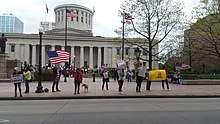
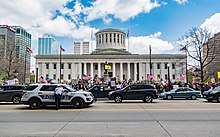
While multiple media outlets praised DeWine and Acton's orders, a group of 75 protested the restrictions on nonessential workers outside the Statehouse during their April 9 press conference.[104] Another protest was staged April 13, reporters commenting that the protesters could be heard and were "pounding on the windows" during the press conference.[105] On April 14, 100 protesters gathered at the Statehouse during DeWine's press conference.[106]
On April 18 several hundred protesters again assembled at the Statehouse.[107] Two men at the protest had a sign with anti-semitic imagery, showing a rat wearing a yarmulke and a Star of David with the caption, "The real plague."[108] Protests continued on April 20 with hundreds gathering outside the Statehouse.[109] On May 1, another large protest occurred during DeWine's press conference.[110] Protests at the statehouse continued the next day.[111]
On April 16, 2020, a Columbus bridal shop owner, represented by the 1851 Center for Constitutional Law, sued Acton for violating the shop owner's constitutional rights because the stay-at-home order provided "no meaningful post-closure process built into it to determine whether a business is 'essential' and can re-open" and asking that the court for a "temporary restraining order that requires the state to provide an immediate hearing for a business closed by the government, in which officials must specifically say why a business is not essential."[112]
In late April, 32 Ohio state representative Republicans called for DeWine to reopen the state's economy completely on May 1.[113]
Primary elections
Ohio's 2020 primary elections were scheduled to be held Tuesday, March 17. DeWine, Acton, and Secretary of State Frank LaRose held an afternoon press conference on Monday, March 16 to cover precautions being taken for the next day's primary election.[55] LaRose issued an order to county boards of election allowing curbside voting.[55]
DeWine recommended pushing the primaries into June[114] but did not think he had the authority to change the date.[115] DeWine and LaRose sought a court order to close down the elections, having former Ohio Department of Aging Director Judith Brachman file a suit in the Franklin County Court of Common Pleas to delay the election, but Judge Richard A. Frye denied it, saying it would set a "terrible precedent" and would represent a judge rewriting election code hours before an election.[115]
Acton, who according to the Columbus Dispatch "has enormous powers during a health emergency", eventually announced at 10:08 pm that polls would be closed as a "health emergency."[115][116] DeWine announced that LaRose would "seek a remedy through the courts to extend voting options so that every voter who wants to vote will be granted that opportunity."[116]
A suit was filed in the Ohio Supreme Court to overturn Acton's action by Perrysburg attorney Andy Mayle on behalf of a candidate for a Wood County Common Pleas judgeship, Corey Spiewak.[117] The court ordered the state to respond to the suit by 1:30 am Tuesday, saying that "Due to exigent circumstances, this matter will be decided on the complaint and answer. No requests or stipulations for extension of time shall be filed, and the clerk of the court shall refuse to file any requests or stipulations for extension of time.[118][118] Ohio Attorney General Dave Yost and Solicitor General Benjamin M. Flowers filed an answer on behalf of LaRose.[119] A decision denying the writ was issued by four justices.[120] The three who did not participate in the decision were Judith French and Sharon Kennedy, both of whom were running for re-election, and Pat DeWine, who is the governor's son.[118]
Private sector response
In late March Battelle Labs in Columbus developed a technology to sterilize N95 masks for reuse, intending to provide 160,000 masks per day in Ohio and to send sterilizing machines to other areas of the US.[121] On March 29 the FDA approved the technology for limited use of up to 10,000 sterilizations per day.[121] DeWine issued a press release condemning this decision that afternoon.[121] Later on March 29, the FDA changed their position, and allowed full use of the technology.[122][123]
Amish businesses switched to producing face masks and shields.[124] Berlin Gardens in Millersburg, normally a maker of garden furniture, was producing 100,000 face shields per day by April 10.[124]
Gojo Industries announced that it would prioritize hospitals and first responders for its Purell hand sanitizer.[125]
Readiness
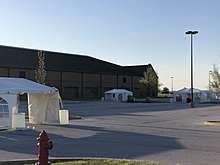
According to Acton, as of March 24 Ohio had 3600 ICU beds and would need to increase that capacity by 50%.[69][126] In Ohio about 26% of patients require hospitalization and about 11% need intensive care.[69][126] As of March 24, Ohio hospitals were at 60% of capacity.[69] In southwest Ohio, hospital executives said they could increase capacity by 20% to 50%.[127]
Acton said on March 24 that Ohio was converting anesthesia machines to respirators, considering which other buildings could be converted into makeshift hospitals, and determining how to safely reuse personal protective equipment such as masks.[69]
Impacts
.jpg)
.jpg)

Source: Ohio coronavirus dashboard[20]
Note: data for most recent several days is preliminary and likely to increase
excludes deaths where date of death is unknown

Source: Ohio coronavirus dashboard[20]
Note: data for most recent several days is preliminary and likely to increase
excludes admissions where date is not yet known
On abortion
On March 17, after Acton issued an order prohibiting nonessential surgeries to preserve personal protective equipment (PPE),[128] DeWine said abortions should be included except when the pregnant woman's life is at risk.[129] Deputy Attorney General Jonathan Fulkerson sent letters to three abortion providers to compel them to comply with the state ban on nonessential medical procedures. District Court judge Michael Barrett ruled in favor of Planned Parenthood on April 1, ordering a two-week suspension of the ban.[130] The State of Ohio appealed Barrett's decision and asked him to put a hold on his order until the appeal was decided, which he declined to do. State of Ohio Attorney General Dave Yost later clarified that all medical abortions were still allowed, and that "doctors remain free to perform surgical abortions necessary for a mother's health or life, and also surgical abortions that cannot be delayed without jeopardizing the patient's abortion rights."[128] On April 6, the State's request for an appeal was dismissed by the United States Court of Appeals for the Sixth Circuit.[131]
On employment
NPR reported on March 24 that "Almost 140,000 people filed for unemployment benefits in Ohio last week compared with fewer than 5,000 a week earlier."[132] On April 7, when asked about delays in filing, Lieutenant Governor Husted said over 500 additional employees had been hired to process applications, bringing the number of employees of Ohio Department of Jobs and Family Services to 829 employees.[102]
On education

On March 10 DeWine asked colleges and universities to go to remote classes.[44] Within several days many private and public colleges and universities had announced campus closings and a move to online classes.[133][134][135][136] On March 12 DeWine closed all K-12 schools starting March 16.[45] On March 30 he extended those closings to May 1.[137] On April 20, he ordered that all K-12 schools in the state remain closed for the rest of the 2019–2020 academic year [138] On May 6, Governor DeWine announced a $775 million budget reduction over the next two months. Spending on K-12 schools will be reduced by $300 million. Spending on other education will be reduced by $55 million and higher education spending will be reduced by $110 million.[139]
On religion
The bishops of the Catholic Conference of Ohio suspended all public Masses in Ohio beginning March 16, dispensing with the obligation to attend Sunday Mass initially through Easter.[140][141][142] On April 28, the suspension of mass and dispensation was extended through May 29.[143] On May 8, the bishops announced the resumption of daily public Masses on May 25, with the dispensation continuing indefinitely.[144]
The Genoa Baptist Church of Westerville, Ohio switched to a drive in format.[145] The Bishop of the East Ohio conference of the United Methodist Church urged the temporary closing of Methodist churches.[146] Ohio's Amish steering committee advised all church districts to heed the state's orders against gatherings of more than 10, telling Amish ”to cancel or postpone weddings, youth and family gatherings until further notice.”[124]
On the restaurant industry

The closing of restaurants and bars affected 22,000 restaurants across the state and 500,000 workers.[147] On March 20 a group of Cincinnati restaurateurs called on the federal government to provide a $225 billion bailout to the US restaurant industry.[148]
On sports
Most of state's sports teams were affected. Several leagues began postponing or suspending their seasons starting 12 March. Major League Baseball cancelled the remainder of spring training on that date, and on March 16, they announced that the season will be postponed indefinitely, after the recommendations from the CDC to restrict events of more than 50 people for the next eight weeks, affecting the Cleveland Indians and Cincinnati Reds.[149] Also on March 12, the National Basketball Association announced the season would be suspended for 30 days, affecting the Cleveland Cavaliers.[150] In the National Hockey League, the season was suspended for an indefinite amount of time, affecting the Columbus Blue Jackets.[151]
In college sports, the National Collegiate Athletic Association cancelled all winter and spring tournaments, most notably the Division I men's and women's basketball tournaments, affecting colleges and universities statewide.[152] On March 16, the National Junior College Athletic Association also canceled the remainder of the winter seasons as well as the spring seasons.[153]
The Summit Motorsports Park announced they would ignore the stay at home order on April 16, and reopen for the 2020 season.[154][155] At a panel held at the Ohio House of Representatives, the owner of the park testified his beliefs that the shutdown of businesses was more for political reasons than for health reasons, and that there was a nationwide mandate to mark every fatality in the United States of America as being caused by COVID-19.[156][157]
On May 20, the Eldora Speedway owned by Tony Stewart, announced one of its largest events of the season would be rescheduled to June 2021 in accordance with the ongoing restrictions on mass gatherings and spectator sports at large venues. [158] A decision on the dirt track's other major events was not announced.
On public transportation
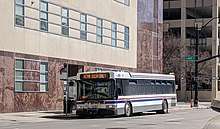
In early March, as the pandemic began affecting Columbus, the city's public transit ridership began dropping, approximately 40 percent. Its public transit agency COTA began by introducing thorough cleaning measures, followed by reducing several rush hour services on March 17. On March 19, it suspended fare collection, making all rides temporarily free, and required passengers to board and depart buses from the rear doors. On the same day, it also modified all rush hour lines, and suspended its AirConnect and Night Owl services. On March 20, the agency recommended only using its services for essential travel; two days later it shut down several rush hour services and reduced frequencies of nine crosstown lines. On March 24, it stopped all rush hour services until further notice.[159] On March 26, the agency began "dynamic service" to pick up customers left at bus stops by too-full buses; the agency's current policy is for a maximum of 20 passengers per bus.[160]
By April 11, the Toledo Area Regional Transit Authority began requiring riders to wear face coverings.[161]
On prisons
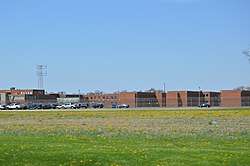
On April 8, the National Guard arrived at Elkton Federal Prison in Columbiana County to assist the medical staff when a large number of prisoners became ill with the virus.[162] On April 18, the National Guard and Highway Patrol arrived at the state prison in Marion county to assist with "mission critical functions" after infections of correctional workers and prisoners.[163] By April 19, over 1800 prisoners at Marion Correctional Institution, approximately 3/4ths of the population, plus 100 staff had tested positive.[164] Overall the prison system had almost 2500 cases by April 19, representing almost a fifth of Ohio's cases.[164] On April 20 Acton said the prison testing results were indicating that as many as 70% of cases may be asymptomatic.[165]
On April 22, the Marion County prison was the top hotspot for the virus in the country, and the Pickaway Correctional Institution was second ranked. Marion County was first in cases per capita in the nation, while Pickaway County was fourth.[166] The Ohio prison system is designed to hold about 35,000 inmates, but held about 49,000 in April, 2020.[167]
On April 22, federal judge James S. Gwin ordered Elkton prison to identify vulnerable inmates and transfer them from the facility. He ordered officials to "evaluate each subclass member's eligibility for transfer out of Elkton through any means, including but not limited to compassionate release, parole or community supervision, transfer furlough or non-transfer furlough within two weeks." He noted “with the shockingly limited available testing and the inability to distance inmates, COVID-19 is going to continue to spread, not only among the inmate population, but also among the staff." He condemned the Federal Department of Corrections, asking "Why has the Justice Department allocated Elkton an entirely insignificant number of tests while Ohio has been able to pull off mass testing across not only Marion, but at multiple institutions?"[168]
On May 19, Gwin ordered federal prison officials to begin the process of releasing eligible inmates at Elkton into home confinement for health and safety reasons. He said that “by thumbing their nose at their authority to authorize home confinement, (prison officials) threaten staff and they threaten low security inmates.” By that date, nine inmates had died from COVID-19. He ordered the release of 837 medically-vulnerable prisoners, (those 65+ or with pre-existing conditions), to home confinement, compassionate release, or to provide detailed reasons for denial. He also chided the prison for slow progress in testing, noting that "despite the obvious need for rapid implementation for mass testing across the entire institution, they are only conducting tests on Mondays and Tuesdays."[169]
See also
- COVID-19 pandemic in Columbus, Ohio
- Timeline of the COVID-19 pandemic in the United States
- COVID-19 pandemic in the United States – for impact on the country
- COVID-19 pandemic – for impact on other countries
References
- Borchardt, Jackie (March 22, 2020). "Ohio Gov. DeWine orders Ohioans to shelter in place, nonessential business, most daycares to close". The Cincinnati Enquirer. Retrieved March 22, 2020.
Ohio Gov. Mike DeWine said in his update Sunday Dr. Amy Acton is ordering a stay at home order or shelter in place order for all Ohioans. The order is in effect beginning midnight Monday and is in effect through April 6. … DeWine said it is time to close most daycares, as well. All childcare centers, beginning on Thursday, must operate under a Temporary Pandemic Child Care license.
- "Welcome to Butler County Health, OH". health.bcohio.us. Retrieved April 6, 2020.
- "COVID-19 Information". www.ccchd.com. Retrieved June 10, 2020.
- "COVID-19". Clermont County Public Health. Retrieved April 6, 2020.
- "Coronavirus". CCBH. January 30, 2020. Retrieved April 6, 2020.
- "Fairfield Department of Health, Fairfield County, Ohio". www.myfdh.org. Retrieved April 14, 2020.
- "Coronavirus Outbreak 2019". www.columbus.gov. Retrieved April 6, 2020.
- "COVID-19 Resources". Hamilton County Public Health. Retrieved April 6, 2020.
- "Coronavirus". www.knoxhealth.com. Retrieved April 14, 2020.
- "Coronavirus Disease (COVID-19)". www.loraincountyhealth.com. Retrieved April 14, 2020.
- "Coronavirus Information". www.lucascountyhealth.com. Retrieved April 7, 2020.
- "Information on COVID-19 (Coronavirus)". marionpublichealth.org. Retrieved April 18, 2020.
- "PHDMC | - Coronavirus Updates". www.phdmc.org. Retrieved April 6, 2020.
- "Ohio, West Central Ohio (WCO), and Montgomery County Confirmed COVId-19 Cases As of 4/2/20". Public Health Dayton and Montgomery County. April 2, 2020. Retrieved April 6, 2020.
- "COVID-19". www.scph.org. April 13, 2020. Retrieved April 14, 2020.
- "Coronavirus (COVID-19) – Warren County Health District". Retrieved April 14, 2020.
- "Coronavirus (COVID-19)". Ohio Department of Health. Retrieved May 2, 2020.
- "COVID-19 Dashboard". Ohio Department of Health. Retrieved May 2, 2020.
- "Ohio Coronavirus Dashboard". Ohio Department of Health. Retrieved April 9, 2020.
- "3 cases of coronavirus confirmed in Cuyahoga County; DeWine declares state of emergency". March 9, 2020. Retrieved March 9, 2020.
- "First case of community spread coronavirus reported in Ohio". WLWT. March 12, 2020. Archived from the original on March 12, 2020. Retrieved March 12, 2020.
- "Coronavirus concerns in Northeast Ohio: Here are the latest updates for March 12, 2020". msn. Archived from the original on March 20, 2020. Retrieved March 19, 2020.
- Cross, Ian (March 13, 2020). "13 coronavirus cases now confirmed in Ohio, 159 under investigation". News5Cleveland. Archived from the original on March 14, 2020. Retrieved March 13, 2020.
- "Coronavirus In Ohio: State Confirms First Death From COVID-19". WOSU Public Media. March 20, 2020. Retrieved March 31, 2020.
- "Coronavirus in Ohio Monday update: 442 cases reported, 6 deaths". nbc4i.com. March 23, 2020.
- "April 14". coronavirus.ohio.gov.
- "April 14 Press conference". Ohio Channel. April 14, 2020. Retrieved April 14, 2020.
- DeWine, Mike (April 17, 2020). "COVID-19 Update: Recovery Phase, Inmate Testing" (Press release).
- Thomas, Matthew (April 25, 2020). "Ohio coronavirus cases near 15,600 as over 700 die from virus". abc6onyourside.com.
- Varkony, Kristine (May 4, 2020). "Coronavirus in Ohio Monday update: 20,474 cases reported, 1,056 deaths". nbc4i.com.
- Borchardt, Jackie (May 12, 2020). "Antibody testing places earliest Ohio coronavirus case in January". Times-Reporter. Retrieved May 13, 2020.
- Polansky, Rachel; Trexler, Phil (May 20, 2020). "3News Investigates: 70% of Ohio's COVID-19 deaths are nursing home patients". WKYC. Retrieved May 22, 2020.
- "Coronavirus in Ohio Tuesday update: 33,006 cases, 2,002 deaths reported". nbc4i.com. May 26, 2020.
- "The US governor who saw it coming early". BBC News. April 1, 2020. Archived from the original on April 1, 2020.
- Basu, Zachary. "States order bars and restaurants to close due to coronavirus". Axios. Archived from the original on March 16, 2020. Retrieved March 16, 2020.
- Bernstein, Lenny (April 9, 2020). "Did Ohio get it right? Early intervention, preparation for pandemic may pay off". Washington Post. Retrieved April 10, 2020.
- Witte, Griff; Zezima, Katie (March 16, 2020). "Ohio Gov. Mike DeWine's coronavirus response has become a national guide to the crisis". Washington Post. Archived from the original on March 17, 2020. Retrieved March 17, 2020.
- Budryk, Zack (March 16, 2020). "Ohio announces liquor buyback program to support bars and restaurants". TheHill. Retrieved March 23, 2020.
- Barrett, Joe (March 29, 2020). "Ohio Governor on Why He Ordered Early, Tough Coronavirus Lockdowns". Wall Street Journal. ISSN 0099-9660. Retrieved March 30, 2020.
- Robbins, Adrienne (March 5, 2020). "Gov. DeWine holds COVID-19 coronavirus preparedness summit". NBC4 WCMH-TV. Archived from the original on March 6, 2020. Retrieved March 17, 2020.
- "Is Ohio ready for coronavirus? Health officials discuss state's plan". WKYC. Retrieved March 17, 2020.
- "3 confirmed cases of coronavirus in Ohio; DeWine declares State of Emergency". March 9, 2020.
- "Ohio asks universities to go to remote learning; wants limits on sports due to coronavirus". Cincinnati.com. Retrieved March 30, 2020.
- "Coronavirus in Ohio: Governor orders schools to take extended spring breaks starting Monday". NBC4 WCMH-TV. March 12, 2020. Retrieved March 12, 2020.
- Krouse, Peter; clevel; .com (March 16, 2020). "Ohio schools to continue feeding children in need during closings prompted by the coronavirus". cleveland. Archived from the original on March 17, 2020. Retrieved March 16, 2020.
- "37 confirmed cases of coronavirus in Ohio; 361 under investigation". WBNS-10TV Columbus, Ohio | Columbus News, Weather & Sports. March 15, 2020. Archived from the original on March 18, 2020. Retrieved March 16, 2020.
- "Ohio Department of Health believes 100,000 Ohioans are carrying coronavirus". WEWS. March 12, 2020. Archived from the original on March 12, 2020. Retrieved March 12, 2020.
- "Coronavirus in Ohio: We've done the infection math for you, and it doesn't look good". Cincinnati.com. Archived from the original on March 16, 2020. Retrieved March 16, 2020.
- Pelzer, Jeremy; clevel; .com (March 14, 2020). "Ohioans should postpone many elective surgeries because of the coronavirus, Gov. Mike DeWine recommends". cleveland. Archived from the original on March 16, 2020. Retrieved March 16, 2020.
- Conradis, Brandon (March 15, 2020). "Illinois, Ohio closing all bars, restaurants in response to coronavirus". thehill.com.
- "Coronavirus: Governor orders Ohio bars, restaurants to shut down". The Columbus Dispatch. March 15, 2020. Archived from the original on March 16, 2020. Retrieved March 15, 2020.
- Knall, Amy (March 16, 2020). "Local restaurants react to state ban". Canton Repository. Canton OH: Gannett. Archived from the original on March 16, 2020. Retrieved March 16, 2020.
- Tobias, Andrew (March 15, 2020). "Ohio Gov. Mike DeWine to expand unemployment to cover workers displaced by coronavirus". cleveland.com. Cleveland OH: AdvanceOhio. Archived from the original on March 15, 2020. Retrieved March 16, 2020.
- "Coronavirus in Ohio Monday update: Election precautions and latest numbers of COVID-19". NBC4 WCMH-TV. March 16, 2020. Archived from the original on March 17, 2020. Retrieved March 16, 2020.
- "Ohio barbershops, hair and nail salons ordered to close amid coronavirus concerns". 10tv.com. March 18, 2010. Archived from the original on March 18, 2020. Retrieved March 18, 2020.
- Tavernise, Sabrina (March 23, 2020). "Texas and Ohio Include Abortion as Medical Procedures That Must Be Delayed". The New York Times. Retrieved March 24, 2020.
- "Coronavirus in Ohio Wednesday update: 88 cases of COVID-19 confirmed". nbc4i.com. March 18, 2020. Archived from the original on March 18, 2020. Retrieved March 18, 2020.
- "DeWine: Businesses should take temperatures of employees every day". nbc4i.com. March 18, 2020. Archived from the original on March 18, 2020. Retrieved March 18, 2020.
- WLWT Digital Staff (March 19, 2020). "Coronavirus latest: 89 cases in Ohio, 35 in Kentucky, 56 in Indiana". WLWT. Retrieved March 19, 2020.
- "Coronavirus in Columbus: Mayor Ginther declares State of Emergency, confirms 2 new cases in city". nbc4i.com. March 18, 2020. Archived from the original on March 18, 2020. Retrieved March 18, 2020.
- Hlavaty, Kaylyn (March 19, 2020). "Gov. DeWine activates 300 personnel from Ohio National Guard to assist with local food distribution". news5cleveland.com.
- "March 20 update". Ohio Channel.
- "Gov. DeWine orders community senior centers and seniors day care facilities closed on Monday". WEWS. March 20, 2020. Retrieved March 21, 2020.
- "March 21". Ohio channel.
- "March 23 press conference". March 23, 2020.
- MacDonald, Evan; clevel; .com (March 23, 2020). "Ohio stops releasing daily unemployment claims numbers amid coronavirus threat at Trump Administration's urging". cleveland. Retrieved March 23, 2020.
- "March 24 Update on NASA Response to Coronavirus – Administrator Jim Bridenstine". blogs.nasa.gov. Retrieved March 30, 2020.
- Johnston, Laura (March 24, 2020). "Ohio Health Director Dr. Amy Acton: Ohio is 7–14 days behind NYC in coronavirus pandemic curve". cleveland.com. Retrieved March 25, 2020.
- "The Ohio Channel". ohiochannel.org. Retrieved March 26, 2020.
- "State leaders say Ohio's peak for coronavirus predicted for mid-May". Toledo Blade. Retrieved March 28, 2020.
- Pelzer, Jeremy; Tobias, Andrew (March 25, 2020). "Ohio legislature passes coronavirus relief bill extending primary voting until April 28, waiving school testing requirements". cleveland.com.
- Hancock, Laura (March 27, 2020). "Ohio coronavirus cases surpass 1,000 mark with 19 deaths: Gov. Mike DeWine's Friday, March 27 briefing". cleveland.com.
- "Ohio confirms 1,406 coronavirus cases, Governor DeWine makes plea to FDA". abc6onyourside.com. March 28, 2020.
- "Coronavirus in Ohio update: 2,547 cases, 65 deaths reported". nbc4i.com. April 1, 2020.
- "Here's what's new about Ohio's extended stay-at-home order". wlwt.com.
- "Cloth Face Coverings". coronavirus.ohio.gov. Retrieved April 5, 2020.
- Wynn, Sarah (April 4, 2020). "Ohio confirms over 100 coronavirus deaths, at least 1,000 hospitalized". abc6onyourside.com.
- Welsh-Higgins, Andrew (April 6, 2020). "Ohio confirms 4,450 cases, with 142 deaths". local12.com.
- Horton, Alex; Bernstein, Lenny (April 10, 2020). "This video of mousetraps and ping-pong balls makes crystal clear why social distancing works". Washington Post. Retrieved April 10, 2020.
- DeWine, Mike (April 15, 2020). "COVID-19 Update: Deferred Elective Procedures, CARES Act Payments, 1099 Unemployment Claims, First Responder PPE, Testing Partnership, Prison Update, Census 2020" (Press release).
- DeWine, Mike (April 16, 2020). "COVID-19 Update: Governor DeWine Discussed State's Plan for Reopening Businesses, Regional Coalition Formed" (Press release).
- "Coronavirus cases over 14,100 in Ohio as 610 people die from infection". abc6onyourside.com. April 22, 2020.
- Anderson, Natasha (April 23, 2020). "COVID-19 threat remains, Ohioans encouraged to take preventative measures as state reopens". fox8.com.
- "Ohio K-12 schools closed for the remainder of the academic year". nbc4i.com. April 20, 2020.
- "'Stay Safe Ohio' order extends some stay-at-home protocol until May 29, with exceptions for reopening". NBC4 WCMH-TV. May 1, 2020. Retrieved May 1, 2020.
- "Coronavirus in Ohio Tuesday update: 28,952 cases, 1,720 deaths reported<". nbc4i.com. May 19, 2020.
- "Coronavirus in Ohio: Gov DeWine announces Dr. Amy Acton has signed new health orders". nbc4i.com. May 20, 2020.
- https://www.cincinnati.com/story/news/2020/06/18/coronavirus-zip-codes-ohio-counties-worrisome-dewine-hamilton-warren/3215930001/
- "Is May 1 too early to start reopening Ohio? Here's what health experts in Cuyahoga County are saying". WKYC. Retrieved April 17, 2020.
- Facher, Lev (April 16, 2020). "Trump outlines 'phases' for reopening states once coronavirus cases begin to decline". statnews.com.
- Borchardt, Jackie (April 27, 2020). "What's in phase 1 of Ohio's coronavirus reopening plan?". Cincinnati.com. Retrieved April 27, 2020.
- "DeWine: Face covering requirement for people in stores 'went too far,' was reversed". 10tv.com. May 3, 2020.
- "Coronavirus in Ohio: Reopening dates given for restaurants, bars, barbershops and salons". nbc4i.com. May 7, 2020.
- "COVID-19 Update: New Responsible RestartOhio Opening Dates" (Press release). May 14, 2020.
- "Coronavirus in Ohio update: 26,954 cases, 1,581 deaths". nbc4i.com. May 15, 2020.
- "Coronavirus in Ohio Thursday update: 30,167 cases, 1,836 deaths". nbc4i.com. May 21, 2020.
- "Coronavirus in Ohio Sunday update: 35,513 cases, 2,155 deaths". nbc4i.com. May 31, 2020.
- "Coronavirus in Ohio Thursday update: 33,915 cases, 2,098 deaths reported". nbc4i.com. May 28, 2020.
- "Coronavirus in Ohio Friday update: 37,758 cases, 2,355 deaths". nbc4i.com. June 5, 2020.
- "Ohio sports allowed to reopen for contact practices starting Monday". nbc4i.com. June 19, 2020.
- April 7, 2020 – #COVID19 Update with Governor Mike DeWine, retrieved April 8, 2020
- Axelrod, Ben (April 8, 2020). "Dr. Amy Acton: Ohio projected to peak with 1,600 new daily coronavirus cases, down from 10,000". WKYC.
- Rosenberg, Gabe. "Coronavirus In Ohio: Protesters Gather Outside Statehouse To Criticize Shutdowns". radio.wosu.org. Retrieved April 10, 2020.
- "daily update April 13".
- Anderson, Chris (April 14, 2020). "Protesters continue to demand that Gov. DeWine lifts Ohio's lockdown orders (video)". cleveland19.com.
- "Photos: Protests over stay-at-home orders at Ohio Statehouse protests". April 18, 2020.
- Hancock, Laura (April 20, 2020). "Some Ohio coronavirus protesters using anti-Semitic symbolism". www.msn.com. Retrieved April 24, 2020.
- Roos, Meghan (April 23, 2020). "OHIO GOVERNOR CONDEMNS 'DISGUSTING' ANTI-SEMITIC SIGN AT CORONAVIRUS LOCKDOWN PROTEST". newsweek.com.
- "WATCH: Protesters gather outside Statehouse as Ohio's stay-at-home order extended". 10tv.com. May 1, 2020.
- Dunigan, Rodney (May 2, 2020). "Protests continue at Ohio Statehouse, organizers call for state to reopen fully". abc6onyourside.com.
- Heisig, Eric (April 16, 2020). "Bridal shop owner, libertarian law firm sue Ohio Health Department Director Dr. Amy Acton over stay-at-home order". cleveland.com. Retrieved April 17, 2020.
- "Ohio Rep. criticizes Dr. Acton, claims masks don't work in Facebook post". WBNS-10TV Columbus, Ohio | Columbus News, Weather & Sports. May 1, 2020. Retrieved May 1, 2020.
- Higgins, Tucker (March 16, 2020). "Ohio governor pushes to extend primary voting from Tuesday until 2 June". CNBC. Archived from the original on March 17, 2020. Retrieved March 16, 2020.
- Balmert, Rebecca Morin, Jackie Borchardt and Jessie. "Ohio election called off by coronavirus 'health emergency' after on-again, off-again day of confusion". USA TODAY. Archived from the original on March 17, 2020. Retrieved March 17, 2020.
- Rouan, Rick. "Coronavirus: Ohio Supreme Court allows delay to primary election". The Columbus Dispatch. Archived from the original on March 17, 2020. Retrieved March 17, 2020.
- Carson, Daniel. "Challenge filed with Ohio high court opposing DeWine's plan to delay primary". The News-Messenger. Retrieved March 17, 2020.
- Tobias, Andrew J.; Hancock, Laura (March 17, 2020). "Citing health emergency, Ohio officials to order polls closed on Election Day, despite judge's ruling". cleveland. Archived from the original on March 17, 2020. Retrieved March 17, 2020.
- "Ohio Secretary of State Frank LaRose's Answer" (PDF). supremecourt.ohio.gov. Retrieved March 17, 2020.
- "Merit Decisions Without Opinions" (PDF). supremecourt.ohio.gov. Archived (PDF) from the original on March 17, 2020. Retrieved March 17, 2020.
- Schladen, Marty. "Coronavirus: FDA gives only limited OK to Battelle's mask-sterilizing technology". The Columbus Dispatch. Retrieved March 29, 2020.
- Schladen, Marty. "Coronavirus: FDA provides full OK for Battelle mask-sterilizing technology". The Columbus Dispatch. Retrieved March 30, 2020.
- Schladen, Marty. "FDA lifts restrictions on Ohio-based Battelle's mask-sterilizing technology amid coronavirus shortages". USA TODAY. Retrieved March 30, 2020.
- Williamson, Elizabeth (April 9, 2020). "In Ohio, the Amish Take On the Coronavirus". The New York Times. ISSN 0362-4331. Retrieved April 10, 2020.
- "GOJO Purell production focused on front lines". The Daily Record. Retrieved April 17, 2020.
- "Trend in Ohio coronavirus cases mirrors New York but is 7 to 14 days behind". Crain's Cleveland Business. March 24, 2020. Retrieved March 25, 2020.
- Saker, Anne (March 13, 2020). "Coronavirus in Ohio: Hospitals say they've trained to 'surge' patient load in pandemics". Cincinnati.com. Retrieved March 25, 2020.
- Rowland, Darrel (April 5, 2020). "Ohio stance on abortion during coronavirus crisis made clear in court filing". The Columbus Dispatch. Retrieved April 7, 2020.
- Tobias, Andrew J. (March 30, 2020). "Federal judge blocks Ohio from using coronavirus health order to restrict abortions". Cleveland.com. Retrieved April 7, 2020.
- Gold, Hannah (April 7, 2020). "Every State That's Tried to Ban Abortion Over the Coronavirus". The Cut. Retrieved April 7, 2020.
- Ingles, Jo (April 6, 2020). "Court Refuses To Overrule Ruling That Stops Ohio From Closing Abortion Clinics". Statehouse News Bureau.
- "Coronavirus Live Updates". NPR.org. Retrieved March 25, 2020.
- "All BGSU students urged to leave; most faculty, staff will work remotely". Sentinel-Tribune. Retrieved March 21, 2020.
- "CAPITAL UNIVERSITY UPDATE: COVID-19". Capital University. March 10, 2020. Retrieved March 29, 2020.
- Bamforth, Emily (March 10, 2020). "Case Western Reserve University moves classes online to protect from coronavirus, encourages students to stay home". cleveland. Retrieved March 23, 2020.
- Newpoff, Laura (March 21, 2020). "Covid-19 updates from Columbus region colleges and universities". columbusmonthly.com.
- March 30, 2020 – #COVID19 Update with Governor Mike DeWine, retrieved March 30, 2020
- Charles Woodman. "Ohio K-12 Students Will Not Return To Class This School Year". News.yahoo.com. Retrieved April 22, 2020.
- "Coronavirus in Ohio update: 21,576 cases, 1,225 deaths reported". nbc4i.com. May 6, 2020.
- "Coronavirus updates in the Archdiocese of Cincinnati". The Catholic Telegraph. Roman Catholic Archdiocese of Cincinnati. March 17, 2020. Retrieved March 22, 2020.
- Schnurr, Dennis Marion; Binzer, Joseph R.; Brennan, Rober J.; Murry, George V.; Binzer, Joseph R.; Oleksiak, Donald P.; Thomas, Daniel Edward (March 16, 2020). "Catholic Bishops of Ohio Suspend All Publicly Celebrated Masses/Liturgies" (PDF) (Press release). Catholic Conference of Ohio. Retrieved March 22, 2020.
- Kilpatrick, Mary (March 16, 2020). "Ohio Catholic bishops cancel Mass through Easter". The Plain Dealer. Retrieved March 16, 2020.
- Schnurr, Dennis Marion; Brennan, Robert J.; Monforton, Jeffrey M.; Monforton, Jeffrey M.; Murry, George V.; Oleksiak, Donald P.; Thomas, Daniel E.; Botean, J. Michael; Danylo, Bohdan J.; Lach, Milan (April 29, 2020). "Catholic Bishops of Ohio Extend Suspension of All Publicly Celebrated Masses/Liturgies Through May 29, 2020" (PDF) (Press release). Catholic Conference of Ohio. Retrieved May 4, 2020.
- Schnurr, Dennis Marion (May 8, 2020). "Archbishop". Roman Catholic Archdiocese of Cincinnati. Retrieved May 16, 2020.
- "Westerville church offering 'drive in' service". WBNS-10TV Columbus, Ohio | Columbus News, Weather & Sports. March 22, 2020. Retrieved March 23, 2020.
- "Ohio bishops make recommendations for Catholics, Methodists". The Vindicator. Retrieved March 23, 2020.
- Knapp, Amy L. "Coronavirus in Ohio | Local restaurants react to state ban". The Repository. Retrieved March 22, 2020.
- Brownfield, Andy (March 20, 2020). "Cincinnati restaurants ask feds for coronavirus bailout". login.research.cincinnatilibrary.org. Retrieved March 22, 2020.
- Feinsand, Mark (March 16, 2020). "Opening of regular season to be pushed back". MLB.com. Archived from the original on March 17, 2020. Retrieved March 16, 2020.
- "Silver: NBA hiatus likely to last 'at least' 30 days". ESPN.com. March 12, 2020. Archived from the original on March 13, 2020. Retrieved March 13, 2020.
- NHL statement on coronavirus Archived 14 March 2020 at the Wayback Machine NHL, 12 March 2020
- NCAA cancels remaining winter and spring championships Archived 12 March 2020 at the Wayback Machine NCAA, 12 March 2020
- NJCAA cancels spring sports, basketball nationals amid coronavirus outbreak Archived 17 March 2020 at the Wayback Machine MLive.com, 16 March 2020
- "'We are starving': Summit Motorsports Park says they're opening for the 2020 season no matter what". WKYC. Retrieved April 17, 2020.
- "'We are starving': Summit Motorsports Park says they're opening for the 2020 season no matter what". WTOL. Retrieved April 17, 2020.
- Rowland, Darrel. "Coronavirus is a plot to threaten Trump re-election, Ohio business owner testifies". The Columbus Dispatch. Retrieved April 21, 2020.
- "Coronavirus is a plot to threaten Trump re-election, Ohio business owner testifies". Cincinnati.com. Retrieved April 21, 2020.
- "Eldora Speedway moves its Dirt Late Model Dream to 2021 - NBC Sports". MotorSportsTalk | NBC Sports. May 20, 2020. Retrieved May 26, 2020.
- "Major Service Change Announcements". Central Ohio Transit Authority. Retrieved March 19, 2020.
- "For Essential Travel, COTA and CoGo Are Still Available (But Scooters Aren't)". Columbus Underground. March 26, 2020. Retrieved March 28, 2020.
- "On first day of TARTA face-covering mandate, most readily comply". Toledo Blade. Retrieved April 17, 2020.
- Ricciutti, Gerry (April 8, 2020). "Ohio National Guard arrives to help sick Elkton inmates". WKBN. Retrieved April 18, 2020.
- "National Guard called to Marion prison as county coronavirus cases near 1,000". Marion Star. April 18, 2020. Retrieved April 18, 2020.
- Cooley, Patrick. "Coronavirus in Ohio: More than 1,800 inmates at Marion Correctional test positive". The Columbus Dispatch. Retrieved April 20, 2020.
- "Ohio Channel April 20 Press conference". Facebook. April 20, 2020. Retrieved April 20, 2020.
- Kandisky, Catherine (April 22, 2020). "Coronavirus surges at Pickaway prison, now No. 2 hot spot in nation – behind Marion prison". Columbus Dispatch. Retrieved April 22, 2020.
- Stewart, Chris; Bischoff, Laura (April 20, 2020). "Coronavirus in Ohio prisons: For Hamilton woman, 'The stress … is horrible'". Journal-News. Retrieved April 22, 2020.
- Balint, Ed (April 22, 2020). "Judge orders transfer of some Elkton prisoners due to COVID-19 risks". The Repository. Retrieved April 23, 2020.
- Balint, Ed (May 19, 2020). "Judge: Elkton prison must begin inmate release". The Repository. Archived from the original on May 22, 2020. Retrieved May 21, 2020.
External links
| Wikimedia Commons has media related to COVID-19 pandemic in Ohio. |